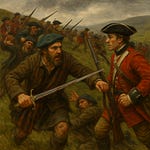Welcome back to "This Day in Scottish History." I'm your host, Colin MacDonald. Today, we delve into a dramatic and chaotic event that unfolded on September 7, 1736—the lynching of Captain John Porteous by an enraged mob in Edinburgh, a pivotal moment in the city's history known as the Porteous Riots.
To set the stage, we must first understand who Captain John Porteous was. Born around 1695, Porteous was the Captain of the City Guard of Edinburgh, a position that made him a figure of authority, responsible for maintaining order in the city. However, Porteous was not a popular man; he was seen as overbearing and harsh, especially by the lower classes of Edinburgh. His reputation would soon take a darker turn following a tragic event in April 1736.
On April 14th of that year, a public execution was scheduled in the Grassmarket, one of Edinburgh's most notorious spots for hangings. Two convicted smugglers, Andrew Wilson and George Robertson, were to be hanged. Wilson, a known smuggler, had garnered some sympathy from the public. The execution drew a large crowd, many of whom were already hostile towards the authorities.
As the execution unfolded, tensions flared. After Wilson was hanged, a disturbance broke out. Captain Porteous, overseeing the City Guard, reacted with aggression. He reportedly fired into the crowd, hitting and killing a man. Then, in a panic or perhaps in a calculated move to assert authority, he ordered his men to fire directly into the crowd. The result was catastrophic: several people were killed, and many more were injured. This brutal response only intensified public outrage against Porteous.
Porteous was swiftly arrested and put on trial for murder. Emotions ran high throughout Edinburgh, and the trial was a major public spectacle. Despite conflicting testimonies about whether Porteous had personally fired his musket, the jury found him guilty of murder. He was sentenced to death, with the execution set for September 8, 1736, back in the very same Grassmarket.
However, this was not to be the end of the story. The events in Edinburgh had caught the attention of the government in London. Alarmed by the unrest, Prime Minister Robert Walpole and Queen Caroline intervened, granting Porteous a reprieve, delaying his execution. This decision was deeply unpopular in Edinburgh. Rumors of a mob lynching began to circulate, and the local authorities took steps to protect Porteous, increasing the guard at his prison cell in the Tolbooth.
But on the night of September 7, 1736, the simmering anger in the city boiled over. A mob of more than four thousand people, reportedly organized with military precision, gathered in the city's west end. They moved through the Grassmarket, the Cowgate, and up to the High Street, converging on the Tolbooth prison. Overpowering the guards, they stormed the prison, broke into Porteous's cell, and dragged him out.
The mob, driven by a thirst for vengeance, took Porteous to the Grassmarket, where they hanged him from a dyer's pole. In a gruesome twist, they then cut him down, stripped him, and hanged him again, this time more securely. The scene was chaotic and brutal, with reports of the mob attempting to set his foot alight and beating him savagely. By the time they were finished, Captain John Porteous was dead, his body hanging lifeless in the night.
The aftermath of the lynching was significant. The government in London was furious. They launched an inquiry, demanding justice for what they saw as a flagrant act of rebellion against the crown's authority. Despite a substantial reward being offered for information, none of those responsible for the lynching were ever caught. Instead, the city of Edinburgh was fined £2,000—a considerable sum at the time, which was used to support Porteous's widow.
The Porteous Riots remain a striking example of public unrest and vigilante justice in Scottish history. They reflected the deep-seated tensions between the government and the people, particularly in Edinburgh, a city fraught with political and social divisions. The event also found its way into literature, most notably in Sir Walter Scott's novel "The Heart of Midlothian," which fictionalizes the dramatic events surrounding the lynching.
As we look back on the night of September 7, 1736, we are reminded of the volatile relationship between authority and the people it governs, a theme that echoes through the ages. Thank you for joining us on this journey through history. Tune in tomorrow for another enlightening episode of "This Day in Scottish History." I'm Colin MacDonald, Haste Ye Back!













Share this post